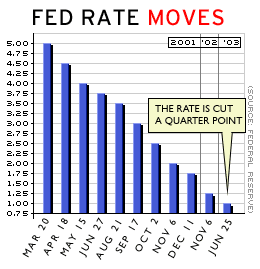NEW YORK (CNN/Money) - After helping spur interest rates to a historic rise, there seems to be little the Federal Reserve can do about it but sit and wait, and maybe talk.

On Friday, that strategy seemed to be paying off as 10-year Treasury note prices surged -- with no help from the Fed -- and yields, which move opposite to price, dropped to their lowest level in nearly two weeks.
But even after the rally, the 10-year Treasury yield -- maybe the most important interest rate to the U.S. economy, since it helps set mortgage rates -- remained more than a full percentage point above its all-time low in mid-June.
The dramatic swing upward in bond rates -- nearly unprecedented in U.S. history, especially at a time when the economy is still relatively weak -- has already snuffed the mortgage refinancing boom, which helped consumers cut their monthly payments and turn home equity into cash, and some economists worry it could sucker-punch the housing market and the broader economy.
"This is an economy that's been struggling to keep its head above water for some time, so this kind of a rise in long-term interest rates is not welcome at this point," said former Fed Governor Lyle Gramley, now a consulting economist with Schwab Washington Research.
Who's to blame?
Some economists and bond traders blame the Fed for this state of affairs -- and the Fed was certainly willing to take the credit when, earlier this spring, long-term rates fell through the floor.
| Related stories
|

|
|
|
|
The central bank normally restricts itself to jimmying short-term interest rates, but the Fed impacted longer-term rates earlier this spring, when its nervous talk about the threat of deflation and its open musing about whether or not it might buy longer-term bonds spurred a bond-buying frenzy.
But then a funny thing happened: The Fed, at its June 25 policy meeting, cut its key short-term interest rate by just a quarter percentage point, disappointing market expectations for a more-aggressive half-point cut.
Shortly before that meeting, a Wall Street Journal report said the Fed likely would abandon plans to buy longer-term Treasury bonds.
| 
| |

| 
| 
|

|
 Justin Lahart, senior writer at CNN/Money, comments on the Fed's upcoming meeting next week. Justin Lahart, senior writer at CNN/Money, comments on the Fed's upcoming meeting next week.
|
 Play video
Play video
(Real or Windows Media)
|
| 
|

|
|
And shortly after the meeting, Fed Chairman Alan Greenspan told Congress he saw signs of an economic turnaround and more or less confirmed the Journal report that a Fed foray into the long end of the Treasury market was unlikely.
What followed was a bond selloff, and interest rates looked like they'd been shot out of a cannon. The Fed, which was vocal in expressing its glee with the bond drop in the spring, has largely been silent ever since.
"I think the back-up in rates should rate a mention -- it's the most significant thing that's happened to the economy in the past seven weeks," said Rory Robertson, interest-rate strategist at Macquarie Equities (USA).
Robertson said the Fed addressing the rise in rates and calling it a bad thing might at least help the bond market believe the Fed feels its pain.
If the Fed wanted to bring down rates, it could also shock everybody and cut its short-term rate again at its next policy meeting, scheduled for Tuesday, which is widely expected to produce neither a rate cut nor anything else particularly interesting.
Of course, such a cut could also badly damage confidence in the economy's chances, and the Fed is probably not even going to discuss it.
"Stocks would really get whacked, because they have priced in that some kind of economic growth is coming," said Robert MacIntosh, chief economist at Eaton Vance Management. "A rate cut would be a sign that growth isn't coming."
Sit and wait?
MacIntosh and many other economists believe technical factors helped push the bond market too far up and then too far down, and that all the Fed really has to do is sit and wait for the market to take care of itself -- as it seemed to do this week.
Other economists believe the Fed should end all the game-playing and just spell out in plain language what its goals are. If it's worried about a drop in inflation, which could set the stage for deflation -- an unstoppable drop in prices that could cripple corporate profits and the economy -- then it should just come out and say it's going to keep interest rates low until it gets inflation back up to a certain percentage.
This kind of inflation targeting is favored by some in the Fed -- including Governor Ben Bernanke, one of the central bank's most important deflation hawks -- but it's apparently anathema to Greenspan, who has all the power.
"My own preference would be for the Fed to state explicitly what it's aiming at," former Fed Governor Gramley said. "That would be helpful in quieting the bond market. But I don't think it's going to happen."

|

